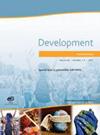报纸背后的人-尤尼特·马鲁达斯-萨克斯和马尔科·波波维奇。
IF 3.7
2区 生物学
Q1 DEVELOPMENTAL BIOLOGY
引用次数: 0
摘要
在水螅再生过程中,细胞上肌动蛋白纤维在再生组织的两个不同部位发生错位。这些线粒体拓扑缺陷部位最终形成了再生动物的新头和新足。在一项新的研究中,Yonit Maroudas-Sacks、Marko Popović、Kinneret Keren及其同事提出了一个正反馈循环,它结合了纤维组织、组织应变和形态发生梯度,以促进头组织器的形成。为了进一步了解这项工作,我们采访了这项工作的第一作者约尼特-马鲁达斯-萨克斯(Yonit Maroudas-Sacks)和共同通讯作者、德国马克斯-普朗克复杂系统物理学研究所组长马尔科-波波维奇(Marko Popović)。本文章由计算机程序翻译,如有差异,请以英文原文为准。
The people behind the papers - Yonit Maroudas-Sacks and Marko Popović.
During Hydra regeneration, supracellular actomyosin fibres are disoriented at two distinct foci of the regenerating tissue. These sites of nematic topological defects eventually form the new head and foot of the regenerated animal. In a new study, Yonit Maroudas-Sacks, Marko Popović, Kinneret Keren and colleagues propose a positive-feedback loop that incorporates fibre organisation, tissue strain and morphogen gradients to promote head organiser formation. To find out more about the work, we caught up with first author Yonit Maroudas-Sacks and co-corresponding author Marko Popović, Group Leader at the Max Planck Institute for the Physics of Complex Systems, Germany.
求助全文
通过发布文献求助,成功后即可免费获取论文全文。
去求助
来源期刊

Development
生物-发育生物学
CiteScore
6.70
自引率
4.30%
发文量
433
审稿时长
3 months
期刊介绍:
Development’s scope covers all aspects of plant and animal development, including stem cell biology and regeneration. The single most important criterion for acceptance in Development is scientific excellence. Research papers (articles and reports) should therefore pose and test a significant hypothesis or address a significant question, and should provide novel perspectives that advance our understanding of development. We also encourage submission of papers that use computational methods or mathematical models to obtain significant new insights into developmental biology topics. Manuscripts that are descriptive in nature will be considered only when they lay important groundwork for a field and/or provide novel resources for understanding developmental processes of broad interest to the community.
Development includes a Techniques and Resources section for the publication of new methods, datasets, and other types of resources. Papers describing new techniques should include a proof-of-principle demonstration that the technique is valuable to the developmental biology community; they need not include in-depth follow-up analysis. The technique must be described in sufficient detail to be easily replicated by other investigators. Development will also consider protocol-type papers of exceptional interest to the community. We welcome submission of Resource papers, for example those reporting new databases, systems-level datasets, or genetic resources of major value to the developmental biology community. For all papers, the data or resource described must be made available to the community with minimal restrictions upon publication.
To aid navigability, Development has dedicated sections of the journal to stem cells & regeneration and to human development. The criteria for acceptance into these sections is identical to those outlined above. Authors and editors are encouraged to nominate appropriate manuscripts for inclusion in one of these sections.
 求助内容:
求助内容: 应助结果提醒方式:
应助结果提醒方式:


